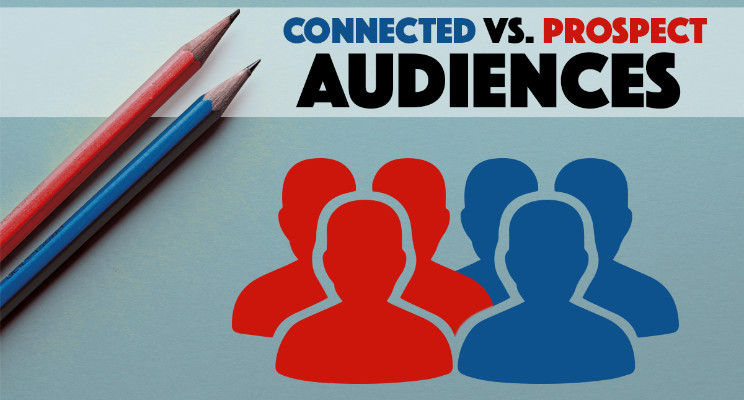A successful Facebook marketing strategy consists of two equally important parts: [killer] content and targeted amplification. While one cannot ever reach its full potential without the other, there are several moving parts within each component that require careful consideration when developing a holistic strategy and reporting standard. In addition to segmenting campaigns by objective for comparative measurement purposes, many brands need to segment “prospect audiences” from “connected audiences” in order to thoroughly evaluate performance.
Audience Categories
Brands can promote a diverse array of content to a wide selection of audiences on Facebook. The amount of audience assessment it takes to find that targeting sweet spot can vary greatly from brand to brand, especially when there are multiple marketing objectives in play. The first question a brand should ask is whether the emphasis is on reaching current/returning customers, or prospecting new ones. The degree of importance in segmenting these two categories heavily depends on the nature of the business and its marketing goals. For example, it makes a lot more sense for a niche online retailer to separate such audience types than it does for a CPG brand that’s relevant to a mass audience (the whole premise behind the P&G Facebook targeting revamp). Put more frankly, in the world of Facebook advertising, not all audiences are created equal.
When it comes to leveraging the robust targeting capabilities available through Facebook, it’s often most useful to break down audiences into two main categories: connected audiences and prospect audiences. While the depth of data layering certainly fluctuates between and within each respective category (with multiple audiences often existing in each), I’ve found this somewhat general distinction between audiences to be the most practical when it comes to analyzing and optimizing campaigns for many brands.
“Connected” Audiences
There are essentially three types of audiences that I have in mind when referencing “connected audiences” on Facebook. Namely: fans, email subscribers, and previous website visitors. While there is sure to be overlap between these different audiences, and additional combinations of data layers can result in much stronger levels of “connection” (e.g. a fan who’s on the email list and has visited the site more than 5 times in the last 30 days vs. a non-fan who’s visited the site just once in the last 3 months), it’s safe to assume that connected audiences are at the very least familiar with my brand. As Jon Loomer points out in his blog Facebook Interest Targeting: How Your Profile is Targeted (The Good and Bad), there is a “level of certainty that when targeting someone connected to me that the content I show them will be accepted or embraced.” That’s not to say that targeting someone who is not connected your brand is useless (after all, isn’t the whole point of marketing to acquire new customers?), it just needs to be understood that these different audience categories can react entirely differently to a piece of content.
“Prospect” Audiences
I classify “prospect audiences” in a way that’s pretty self explanatory: any audience that does not fall into the “connected” category. Essentially, “prospect audiences” refers to users that are identified without using any 1st party data from a brand. Even though these potential consumers may never have interacted with my brand or site, I am making a highly-educated guess (if I’m doing my job right!) based on Facebook’s native targeting data that my content will be seen as relevant. More specifically, these audiences are constructed using lookalike modeling along with behavioral, interest-based, and demographic data available through Facebook. These are the users that we want to proactively funnel into our connected audience category as we aim to expand awareness and encourage brand exploration. While content should be tailored to the different audiences who might exist in the various levels of the funnel, plenty of content remains relevant for both connections and prospects. Think about this example: a travel site is running a special sale campaign and wants to target both connected and prospect audiences. It’s probably safe to assume that a connected audience (such as email subscribers) will significantly outperform a prospect audience (such as interests in competitor travel sites). Lumping the performance data from the campaign will surely result in a deceptive average that doesn’t tell the whole story (especially if budget distribution differs between connected and prospect audiences from campaign to campaign).
Conclusion
Nurturing existing connections and fostering brand discovery amongst new consumers are both integral goals of a winning Facebook marketing strategy. Understanding how audiences within those two different categories of consumer persona perform through various campaigns can help marketers make better (data) informed budgeting decisions and optimization strategies. As previously mentioned, segmentation between connected and prospect audiences doesn’t make sense for every brand. However, overlooking the inherent discrepancies in performance that can occur between the two audience categories can result in a misguided analysis of channel performance.
Your Turn
Is your brand or agency breaking out performance by audience category? Should they be?


